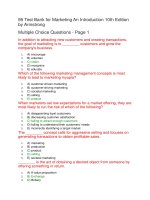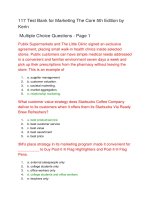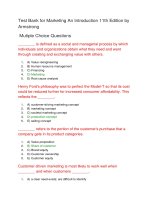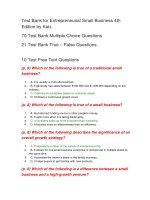Test bank for entrepreneurial small business 4th edition by katz
Bạn đang xem bản rút gọn của tài liệu. Xem và tải ngay bản đầy đủ của tài liệu tại đây (238.83 KB, 73 trang )
TEST BANK FOR ENTREPRENEURIAL SMALL BUSINESS 4TH
EDITION BY KATZ
True / False Questions
1. The U.S. government agency that helps people start small businesses is the U.S.
Department of Commerce.
True
False
2. Entrepreneurs are exclusively found in farming-related occupations.
True
False
3. Small-scale entrepreneurs are only allowed to trade in sale of goods and not in trades
of service.
True
False
4. Truly entrepreneurial businesses are characterized by imitativeness in their products,
services, or business models.
True
False
5. Self-employed persons are not referred to as entrepreneurs.
True
False
6. Small businesses focus on effectiveness, whereas high-growth ventures focus on
efficiency.
True
False
7. Small businesses start small but are intended to grow rapidly, often requiring a team
of partners.
True
False
8. Lifestyle or part-time firms typically provide enough profit or salary to supplement an
income but usually not enough on which to live.
True
False
1-1
© 2014 by McGraw-Hill Education. This is proprietary material solely for authorized instructor use. Not authorized for sale or distribution
in any manner. This document may not be copied, scanned, duplicated, forwarded, distributed, or posted on a website, in whole or part.
9. Traditional small businesses' schedules are defined by the owners' needs.
True
False
10. High-growth ventures are also known as main street businesses.
True
False
11. Flexibility rewards refer to the money made from owning a business.
True
False
12. Flexibility rewards are the most rapidly growing type of reward.
True
False
13. Using low-cost or free techniques to minimize cost of doing business is referred to as
bootstrapping.
True
False
14. Ninety percent of all new businesses fail within two years.
True
False
15. The most frequently occurring element of the BRIE model is intention.
True
False
16. In the BRIE model, exchange refers to moving resources, goods, or services to others,
in exchange for money or other resources.
True
False
17. The disadvantage of the BRIE model is that it does not mention the management of
resources.
True
False
18. One of the key elements of the BRIE model is a person's intentions to start a
business.
True
False
19. High-growth ventures and big businesses generally do not succeed without small
businesses offering supporting services.
True
False
1-2
© 2014 by McGraw-Hill Education. This is proprietary material solely for authorized instructor use. Not authorized for sale or distribution
in any manner. This document may not be copied, scanned, duplicated, forwarded, distributed, or posted on a website, in whole or part.
20. Entrepreneurship levels are very high in efficiency-driven economies.
True
False
21. The primary focus of corporate entrepreneurship is creating new civic organizations
which are financially self-sufficient.
True
False
Multiple Choice Questions
22. The _____ is a U.S. government agency that helps people start a business and also
provides them support and advocacy.
A. Small Business
Administration
B. U.S. Department of Business
Development
C. U.S. Department of
Commerce
D. U.S. Entrepreneurial
Administration
23. Truly entrepreneurial businesses are characterized by:
A. the franchise they are associated
with.
B. the degree to which their products are
imitative.
C. the novelty in their products, services, or business
models.
D. the ease with which their product is accepted by the
buyers.
1-3
© 2014 by McGraw-Hill Education. This is proprietary material solely for authorized instructor use. Not authorized for sale or distribution
in any manner. This document may not be copied, scanned, duplicated, forwarded, distributed, or posted on a website, in whole or part.
24. Small businesses are usually:
A. imitative in
nature.
B. characterized by the novelty of their
products.
C. the same as high-growth
ventures.
D. not affected by market
fluctuations.
25. Which of the following is true of a franchise?
A. It is the international term for all small
businesses.
B. It is a type of novelty
organization.
C. It is an organization that provides loans to start small
businesses.
D. It is a prepackaged business bought, rented, or leased from a
company.
26. A person who becomes an owner by inheriting or getting a stake in a family business
is known as a _____.
A. found
er
B. franchis
or
C. hei
r
D. serial
entrepreneur
27. A business owned by an individual or a little group is referred to as a(n):
A. corporate
chain.
B. conglomerat
e.
C. concer
n.
D. independent small
business.
1-4
© 2014 by McGraw-Hill Education. This is proprietary material solely for authorized instructor use. Not authorized for sale or distribution
in any manner. This document may not be copied, scanned, duplicated, forwarded, distributed, or posted on a website, in whole or part.
28. A business run by the individual who owns it is referred to as a(n) _____.
A. franchis
e
B. owner-managed
firm
C. professionally-owned
business
D. novelty
firm
29. Which of the following is true of a small business?
A. Its preferred funding source is other people's
money.
B. It sells more when it is facing
bankruptcy.
C. It considers sales as more important than
marketing.
D. It focuses more on effectiveness than on
efficiency.
30. Small businesses differ from high-growth ventures in that in small businesses:
A. the focus is on effectiveness rather than
efficiency.
B. the preferred source of funding is the owner's own money rather than other
people's money.
C. the delegation of responsibilities is easy and necessary rather
than difficult.
D. themetastrategy is for novelty rather than
imitation.
31. High-growth ventures differ from small businesses in that in high-growth ventures:
A. the focus is on efficiency rather than
effectiveness.
B. the preferred source of funding is the owner's own money rather than other
people's money.
C. the human resource system is personalized rather than
professionalized.
D. the limitation of growth is dictated by market response rather than the owner's
loss of control.
1-5
© 2014 by McGraw-Hill Education. This is proprietary material solely for authorized instructor use. Not authorized for sale or distribution
in any manner. This document may not be copied, scanned, duplicated, forwarded, distributed, or posted on a website, in whole or part.
32. Which of the following is a characteristic of a small business?
A. Source of funding is primarily other people's
money
B. Focus is on
efficiency
C. Professionalized approach to human
resource
D. Delegation is
essential
33. Which of the following is true of a high-growth venture?
A. It considers sales as more important than
marketing.
B. Its metastrategy is
novelty.
C. It focuses more on efficiency than on
effectiveness.
D. It does not allow for easy delegation of work or
responsibilities.
34. Which of the following is an attribute of a high-growth venture?
A. Its preferred funding source is the owner's own
money.
B. Its metastrategy is
imitation.
C. It grows when
necessary.
D. It considers delegation
essential.
35. Which of the following is a difference between a small business and a high-growth
venture?
A. For a small business, the preferred funding source is other people's money,
whereas for a high-growth venture, it is the owner's own money.
B. For a small business, the personal control preference is to involve others, whereas
a high-growth venture prefers to retain autonomy.
C. A small business focuses on effectiveness, whereas a high-growth venture focuses
on efficiency.
D. A small business grows when necessary, whereas a high-growth venture grows
when possible.
1-6
© 2014 by McGraw-Hill Education. This is proprietary material solely for authorized instructor use. Not authorized for sale or distribution
in any manner. This document may not be copied, scanned, duplicated, forwarded, distributed, or posted on a website, in whole or part.
36. High-growth ventures:
A. use imitation as their
metastrategy.
B. start small but are intended to grow
rapidly.
C. cannot include a team of
partners.
D. do not delegate
tasks.
37. Which of the following describes the significance of an overall growth strategy?
A. It represents a driver of the variety of
entrepreneurship.
B. It allows for one small business enterprise to incorporate in multiple states at
the same time.
C. It provides the owner a stake in the family
business.
D. It helps buyers to get familiar with new
products.
38. Which of the following is a characteristic of a lifestyle firm?
A. It starts small and grows very rapidly to become a big
business.
B. It represents about 20 percent of all
businesses.
C. It typically has sales of $25,000 a year
or less.
D. It aims to achieve growth rates of 25 percent or
more a year.
39. Which of the following is true of a part-time firm?
A. It starts small and stays very
small.
B. It has a continuous
growth.
C. Its success is defined by annual profits of
$1,000,000.
D. It aims to achieve growth rates of 25 percent or
more a year.
1-7
© 2014 by McGraw-Hill Education. This is proprietary material solely for authorized instructor use. Not authorized for sale or distribution
in any manner. This document may not be copied, scanned, duplicated, forwarded, distributed, or posted on a website, in whole or part.
40. In lifestyle firms:
A. success is defined by sales of between $100,000 and
$1,000,000.
B. schedules are defined by customer
needs.
C. the income generated usually provides a living for the owner
and family.
D. growth tends to quickly
level off.
41. Which of the following categories does the majority of small businesses fall under?
A. High-growth
ventures
B. High-performing small
businesses
C. Lifetime/Part-time
firms
D. Traditional small
business
42. _____ are the smallest full-time business.
A. High-performing small
businesses
B. Traditional small
businesses
C. High-growth
ventures
D. Lifestyle
businesses
43. Which of the following is true of a traditional small business?
A. It is usually a multi-site
business.
B. It generally has sales between $100,000 and $1,000,000 depending on
the industry.
C. It defines its schedules based on customer
needs.
D. It follows a continuous growth
curve.
1-8
© 2014 by McGraw-Hill Education. This is proprietary material solely for authorized instructor use. Not authorized for sale or distribution
in any manner. This document may not be copied, scanned, duplicated, forwarded, distributed, or posted on a website, in whole or part.
44. Which of the following is a characteristic of a traditional small business?
A. It is often a one-site
business.
B. It follows a continuous growth
curve.
C. It defines its schedules based on the owner's
needs.
D. It generally has sales between $100,000 and $1,000,000 depending on
the industry.
45. A traditional small business generally has sales of between:
A. $100,000 and
$1,000,000.
B. $100,000 and
$200,000.
C. $25,000 and
$100,000.
D. $50,000 and
$80,000.
46. Which of the following is true of the growth of a typical traditional small business?
A. It tends to quickly level off after the owners operate long enough to learn the
basics of making money.
B. It levels off after operations settle into a consistent, money-making pattern
generating income to provide a living for the owner.
C. It grows at rates between 5 to 15 percent
a year.
D. It grows at rates of 25 percent or more
a year.
47. _____ tend to level off after success defined by sales of between $100,000 and
$1,000,000, depending on the industry.
A. Lifestyle
firms
B. Traditional small
businesses
C. High-performing small
businesses
D. High-growth
ventures
1-9
© 2014 by McGraw-Hill Education. This is proprietary material solely for authorized instructor use. Not authorized for sale or distribution
in any manner. This document may not be copied, scanned, duplicated, forwarded, distributed, or posted on a website, in whole or part.
48. Which of the following is true of a high-performing small business?
A. It often grows through multiple
locations.
B. It aims to achieve growth rates of 25 percent or
more a year.
C. It has sales of more than $1
million.
D. It has low levels of
professionalization.
49. Which of the following is a characteristic of a high-growth venture?
A. It pursues low levels of
professionalization.
B. It levels off after operations settle into a consistent, moneymaking pattern.
C. It aims to achieve growth rates of 25 percent or
more a year.
D. Its success is defined by sales of between $100,000 and $1,000,000
annually.
50. Lifestyle firms, traditional small businesses, and high-performing small businesses
are often called _____.
A. main street
businesses
B. Wall Street
businesses
C. high-growth
ventures
D. universal
businesses
51. Which of the following is a reward universally mentioned by entrepreneurs?
A. Peer
admiration
B. Personal
growth
C. Political
power
D. Industry
recognition
1-10
© 2014 by McGraw-Hill Education. This is proprietary material solely for authorized instructor use. Not authorized for sale or distribution
in any manner. This document may not be copied, scanned, duplicated, forwarded, distributed, or posted on a website, in whole or part.
52. _____ is a reward universally mentioned by entrepreneurs.
A. Industry
recognition
B. Peer
admiration
C. Political
power
D. Work
flexibility
53. Which of the following is a reward that is rarely mentioned by entrepreneurs?
A. To have a chance to build great
wealth
B. To have greater flexibility for personal and
family life
C. To continue a family
tradition
D. To develop an idea for a
product
54. _____ rewards are those which people get from facing and beating or learning from
challenges.
A. Recognitio
n
B. Flexibili
ty
C. Incom
e
D. Growt
h
55. Which of the following rewards refer to the money made from owning a business?
A. Growth
rewards
B. Flexibility
rewards
C. Income
rewards
D. Performance
rewards
1-11
© 2014 by McGraw-Hill Education. This is proprietary material solely for authorized instructor use. Not authorized for sale or distribution
in any manner. This document may not be copied, scanned, duplicated, forwarded, distributed, or posted on a website, in whole or part.
56. Tina runs her consultancy business from her home. Working from home allows her to
set her own schedule and take time off at her convenience so that she can be with
her family. The fact that Tina gets more time with her family can be categorized as
______ reward.
A. incom
e
B. flexibili
ty
C. growt
h
D. cred
it
57. The ability of business owners to structure their lives in the way that best suits their
needs refers to:
A. flexibility
rewards.
B. family
rewards.
C. growth
rewards.
D. wealth
rewards.
58. Which of the following is a myth about small businesses?
A. That failed entrepreneurs can succeed if they
try again
B. That a small business will never have enough
financing
C. That students have skills to start small
businesses
D. That small businesses can start during
recession
1-12
© 2014 by McGraw-Hill Education. This is proprietary material solely for authorized instructor use. Not authorized for sale or distribution
in any manner. This document may not be copied, scanned, duplicated, forwarded, distributed, or posted on a website, in whole or part.
59. Financing a business online through the collective involvement of others who provide
donations, loans, or investments is referred to as _____.
A. crowdfundi
ng
B. bootstrappi
ng
C. microfinanci
ng
D. crowdsourci
ng
60. Bootstrapping refers to:
A. funding a business online through the collective involvement of others who
provide loans.
B. buying, renting, or leasing a prepackaged business from another
company.
C. inheriting or being given a stake in a family
business.
D. using low-cost or free techniques to minimize the cost of doing
business.
61. Anna helps brides-to-be choose wedding gowns that best suit their requirements and
budget, and also helps them with where they can find the right dress. She has made
her home her virtual office; she does not require external financing. Anna is using
_____ to run her small business.
A. crowdfundi
ng
B. franchisi
ng
C. bootstrappi
ng
D. crowdsourci
ng
1-13
© 2014 by McGraw-Hill Education. This is proprietary material solely for authorized instructor use. Not authorized for sale or distribution
in any manner. This document may not be copied, scanned, duplicated, forwarded, distributed, or posted on a website, in whole or part.
62. According to the BRIE model, which of the following is an element that is necessary to
start a business?
A. Boundar
y
B. Recognitio
n
C. Efficienc
y
D. Incom
e
63. According to the BRIE model, _____ sets up a business as a firm.
A. intenti
on
B. exchang
e
C. franchis
e
D. bounda
ry
64. According to the BRIE model, which of the following sets a firm off from the buying or
selling or bartering done casually by nonmerchants?
A. Resource
s
B. Boundar
y
C. Intenti
on
D. Exchang
e
1-14
© 2014 by McGraw-Hill Education. This is proprietary material solely for authorized instructor use. Not authorized for sale or distribution
in any manner. This document may not be copied, scanned, duplicated, forwarded, distributed, or posted on a website, in whole or part.
65. According to the BRIE model, which of the following falls under the boundary
category?
A. The financial resources of a
company
B. The desire to start a
business
C. An e-mail address of the
company
D. A product or service offered by the
company
66. John owns a small business that does computer servicing. Which of the following
would represent boundary as mentioned in the BRIE model in John's computer
servicing business?
A. The employees that work under
John
B. The office in which John
works
C. The money earned by John from the
business
D. The desire to expand the business to writing
software
67. In the BRIE model, a business name or government registration, a phone or e-mail
address dedicated to the business, or a specific location for the firm in a home,
commercial space, or on the Internet represents:
A. exchang
e.
B. resourc
e.
C. boundar
y.
D. intentio
n.
1-15
© 2014 by McGraw-Hill Education. This is proprietary material solely for authorized instructor use. Not authorized for sale or distribution
in any manner. This document may not be copied, scanned, duplicated, forwarded, distributed, or posted on a website, in whole or part.
68. According to the BRIE model, which of the following is true of a resource?
A. It includes a business name or government
registration.
B. It refers to moving goods or services to others for
money.
C. It is the most frequently occurring element of the
BRIE model.
D. It includes the product or service to be
offered.
69. Which of the following is the most frequently occurring element of the BRIE model?
A. Intenti
on
B. Boundar
y
C. Exchang
e
D. Resource
s
70. Which of the following elements of the BRIE model represents the desire to start a
business?
A. Intenti
on
B. Boundar
y
C. Exchang
e
D. Resource
s
71. In terms of new jobs, which of the following is true of a small business?
A. It does not employ people looking for parttime work.
B. It is of no importance to existing
jobs.
C. It offers jobs to people with atypical work
histories.
D. It pays taxes on behalf of the people it
hires.
1-16
© 2014 by McGraw-Hill Education. This is proprietary material solely for authorized instructor use. Not authorized for sale or distribution
in any manner. This document may not be copied, scanned, duplicated, forwarded, distributed, or posted on a website, in whole or part.
72. The way that newly created goods, services, or firms hurt existing goods, services, or
firms is referred to as:
A. benchmarkin
g.
B. creative
destruction.
C. service
distortion.
D. crowdsourcin
g.
73. Mandarin In Town, a Chinese restaurant, opened recently in Burnsville, Minnesota.
People from all over the town flocked to Mandarin to find out how good it was. This
gave a big boost to the restaurant's initial business, but it caused the other
restaurants in the area to lose business temporarily. The way in which Mandarin in
Town hurt existing restaurants in Burnsville is an example of:
A. creative
destruction.
B. service
distortion.
C. innovative
disruption.
D. crowdsourcin
g.
74. According to the U.S. Small Business Administration, small businesses generate _____
times the number of patents per employee than do big businesses.
A. 35.
5
B. 2.
5
C. 16.
5
D. 50.
5
1-17
© 2014 by McGraw-Hill Education. This is proprietary material solely for authorized instructor use. Not authorized for sale or distribution
in any manner. This document may not be copied, scanned, duplicated, forwarded, distributed, or posted on a website, in whole or part.
75. A nation where the major forces for jobs, revenues, and taxes come from farming or
extractive industries like forestry, mining, or oil production is a(n):
A. factor-driven
economy.
B. efficiency-driven
economy.
C. innovation-driven
economy.
D. competency-driven
economy.
76. In factor-driven economies:
A. entrepreneurship levels are in the middle
range.
B. entrepreneurship levels are very
high.
C. entrepreneurship levels are very
low.
D. entrepreneurship is not given any
consideration.
77. A nation where industrialization is the major force providing jobs, revenues and taxes,
and where minimizing costs while maximizing productivity is a major goal is a(n):
A. factor-driven
economy.
B. efficiency-driven
economy.
C. innovation-driven
economy.
D. effectiveness-driven
economy.
1-18
© 2014 by McGraw-Hill Education. This is proprietary material solely for authorized instructor use. Not authorized for sale or distribution
in any manner. This document may not be copied, scanned, duplicated, forwarded, distributed, or posted on a website, in whole or part.
78. In efficiency-driven economies:
A. entrepreneurship levels are in the middle
range.
B. entrepreneurship levels are very
high.
C. entrepreneurship levels are very
low.
D. entrepreneurship is not given any
consideration.
79. Innovation-driven economies:
A. are those where entrepreneurship becomes a key way to build the
middle class.
B. are nations where industrialization is becoming the major force providing jobs,
revenues, and taxes.
C. are focused on high-value-added manufacturing but are marked by a very large
service sector.
D. are those where entrepreneurship is essential to build personal wealth and break
the cycle of low-wage jobs.
80. In innovation-driven economies:
A. entrepreneurship levels are in the middle
range.
B. entrepreneurship levels are very
high.
C. entrepreneurship levels are lower compared to factor-driven
economies.
D. entrepreneurship is not given any
consideration.
81. Virtual instant global entrepreneurship refers to:
A. the transformation of a high-growth venture into a small
business.
B. a person becoming an owner by inheriting or getting a stake in a
family business.
C. the way that newly created goods, services, or firms hurt existing goods,
services, or firms.
D. a process that uses the Internet to quickly create businesses with a
worldwide reach.
1-19
© 2014 by McGraw-Hill Education. This is proprietary material solely for authorized instructor use. Not authorized for sale or distribution
in any manner. This document may not be copied, scanned, duplicated, forwarded, distributed, or posted on a website, in whole or part.
82. Which of the following aspects of entrepreneurship refers to being in-tune with one's
market?
A. Efficienc
y
B. Creatio
n
C. Customerfocus
D. Growt
h
83. The form of entrepreneurship in which a person or group own their own for-profit
business is referred to as:
A. independent
entrepreneurship.
B. social
entrepreneurship.
C. public
entrepreneurship.
D. corporate
entrepreneurship.
84. _____ is an aspect of entrepreneurship that refers to doing the most work with the
fewest resources.
A. Innovati
on
B. Creatio
n
C. Efficienc
y
D. Customerfocus
1-20
© 2014 by McGraw-Hill Education. This is proprietary material solely for authorized instructor use. Not authorized for sale or distribution
in any manner. This document may not be copied, scanned, duplicated, forwarded, distributed, or posted on a website, in whole or part.
85. _____ is an aspect of entrepreneurship which looks at a new thing or a new way of
doing things.
A. Customerfocus
B. Innovati
on
C. Creatio
n
D. Efficienc
y
86. Which of the following types of entrepreneurship typically concentrates on innovation
and customer-focus among all aspects of entrepreneurship?
A. Public
entrepreneurship
B. Corporate
entrepreneurship
C. Independent
entrepreneurship
D. Social
entrepreneurship
87. Which of the following is true of corporate entrepreneurship?
A. It involves the creation of self-sustaining charitable and civic
organizations.
B. It involves revitalizing government
agencies.
C. It is a form of entrepreneurship in which people own their own forprofit business.
D. It involves bringing new products or services to a
market.
1-21
© 2014 by McGraw-Hill Education. This is proprietary material solely for authorized instructor use. Not authorized for sale or distribution
in any manner. This document may not be copied, scanned, duplicated, forwarded, distributed, or posted on a website, in whole or part.
88. Social entrepreneurship primarily involves a person or group:
A. creating new charitable and civic organizations which are financially
self-sufficient.
B. bringing new products or services to
market.
C. owning their own for-profit
business.
D. revitalizing government
agencies.
89. Which of the following is true of social entrepreneurship?
A. It usually has a lot of
funding.
B. It creates organizations which are usually financially dependent on
other firms.
C. It cannot be initiated by a for-profit
company.
D. It does not include innovation as a key
element.
90. _____ is the degree of attention a target market pays to an idea or organization.
A. Crowdfundi
ng
B. Effectuati
on
C. Mindshar
e
D. Crowdfundi
ng
91. Effectuation refers to:
A. the degree of attention a target market pays to an idea or
organization.
B. an approach used to create alternatives in uncertain
environments.
C. transforming a high-growth venture into a small
business.
D. a process of a person becoming an owner by inheriting or getting a stake in a
family business.
1-22
© 2014 by McGraw-Hill Education. This is proprietary material solely for authorized instructor use. Not authorized for sale or distribution
in any manner. This document may not be copied, scanned, duplicated, forwarded, distributed, or posted on a website, in whole or part.
Essay Questions
92. What is the difference between small businesses and high-growth ventures?
93. Briefly describe the three universally mentioned and four rarely mentioned rewards.
94. What are the most common myths about small businesses? What are the facts that
contradict these myths?
1-23
© 2014 by McGraw-Hill Education. This is proprietary material solely for authorized instructor use. Not authorized for sale or distribution
in any manner. This document may not be copied, scanned, duplicated, forwarded, distributed, or posted on a website, in whole or part.
95. Briefly describe the BRIE model.
96. What is the role of small businesses in creating new jobs?
97. What is creative destruction?
98. What is a factor-driven economy?
1-24
© 2014 by McGraw-Hill Education. This is proprietary material solely for authorized instructor use. Not authorized for sale or distribution
in any manner. This document may not be copied, scanned, duplicated, forwarded, distributed, or posted on a website, in whole or part.
99. What is VIGE? Explain.
100 What are the different aspects of entrepreneurship?
.
101 What are the different forms of entrepreneurship?
.
1-25
© 2014 by McGraw-Hill Education. This is proprietary material solely for authorized instructor use. Not authorized for sale or distribution
in any manner. This document may not be copied, scanned, duplicated, forwarded, distributed, or posted on a website, in whole or part.









